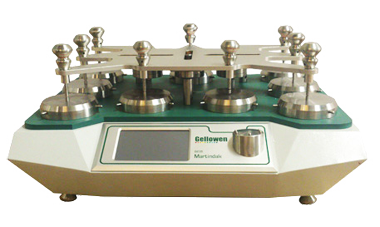
NewsInformation Center
Martindale wear tester test details analysis
2021/10/15
1. Maintenance of Martindale Abrasion Tester
In order to comprehensively and accurately express the wear resistance of textiles, the test requires good accuracy and repeatability. This article discusses the factors that affect Martindale's test results from the three aspects of instrument maintenance, sample preparation, and operating specifications, so as to improve the accurate habit of using the measurement results.
1. Maintenance of Martindale instruments
The state of the instrument determines the reliability of the test results. In order to ensure the accuracy of the test, it is necessary to ensure that the test instrument is in a * state. In addition to routine cleaning and maintenance, regular inspections of instrument performance are required.
1. 1. Control of the pressure applied by the specimen holding head
When using Martindale to conduct abrasion resistance test, it is necessary to apply a certain pressure to the sample, and the size of the pressure will directly affect the friction effect. If the pressure is too small, the friction will be too light, and the test result will be better than the actual performance of the sample; on the contrary, if the pressure is too large, the damage to the sample will be aggravated and the test result will be biased.
1. 2. The accuracy of the friction counter
When using Martindale for abrasion resistance test, the number of frictions needs to be counted in order to rate the wear caused by different friction times. At this time, if the friction counter fails, it will affect the friction times in the test and cause errors.
2. Preparation of the sample
The sample selection in the test determines the representativeness of the sample.
1. Selection of samples
In order to provide the representativeness of the sample, it is necessary to select the parts containing different warp and weft yarns, and special attention should be paid to the samples of some special properties. For example, the sample of the printed fabric should include the entire pattern to avoid missing some parts sensitive to friction; the woven fabric needs to keep a certain distance from the edge of the door. In addition, the number of samples selected also affects the accuracy and repeatability of the test. The larger the number of samples tested, the stronger the representativeness and the higher the accuracy. On the contrary, the smaller the number, the greater the randomness of the test results and the lower the reliability. The minimum number of samples selected is 3.
2. Pretreatment of the sample
Since the fabric is wrapped and wound before being tested, it is in a tight state. For better testing, it needs to be placed in a standard state and spread for a period of time to restore the tested fabric from the tight state. If the pretreatment is not in place, the fabric is in a taut state and the wear resistance becomes poor, which will affect the accuracy of the test.
3, the standardization of experimental operations
In order to ensure correct operation, it is necessary to train experiment operators. During the operation, pay attention to the sample placement and clamping tightness, which will not cause extra stretching effect due to excessive tightness, nor too loose, so that the surface of the sample is too loose, bulging and affecting the test results.
The above is the details of the relevant content that the Standard Group has answered in detail for you. I hope to help you. If you need to purchase products, please leave a message to us or email: info@qinsun-lab.com.
Previous: Jordan's garment and textile industry is facing serious difficulties
N e x t : Talking about the plane abrasion test of textiles




